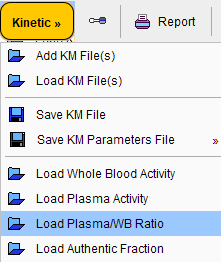The sequential steps for converting blood measurements to an input curve are explained in a dedicated section. The current plasma fraction model serves for converting a whole-blood activity curve into a plasma-activity curve.
It is assumed that a curve representing the measured fractions of plasma/whole-blood activity has been loaded with Load Plasma/WB Fraction.

Operational Model Curve
The Watabe model allows replacing the tail of the fraction curve by an analytical function. The Begin parameter defines at what time the models switches from linear interpolation to the Hill function.

The illustration below shows an example with the Hill function fitted following 2 minutes (Begin = 120sec). The the weighting has been changed for putting more emphasis on the tail. Note that the linear interpolation assumes a fraction of 1 at t=0.

Parameter Fitting
The model supports the fitting of the parameters Begin, scale, A, B, C. Fitting is started with the Fit plasma fraction button, which only takes the samples after the Begin time into consideration.
Use without Measured Fraction
If no measured plasma/whole-blood fraction data is available, the Watabe model can still be applied. In this case the Begin time is disregarded, and the functional defined by the entered parameters applied.
References
1.Watabe H, Channing MA, Der MG, Adams HR, Jagoda E, Herscovitch P, Eckelman WC, Carson RE: Kinetic analysis of the 5-HT2A ligand [11C]MDL 100,907. J Cereb Blood Flow Metab 2000, 20(6):899-909. DOI